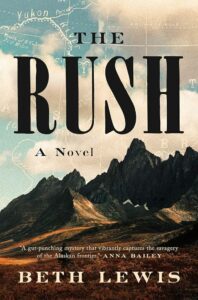 Set in the late 1890s in the Klondike during the gold rush, this is epic story telling in the good old fashioned sense of the word, with the sweep of books like Gone with the Wind, Hawaii or Shogun. Author Lewis familiarizes the reader vividly with the hardships of simply surviving in the hostile climate of Klondike (then as now a part of Canada, not Alaska) while staking out a claim and mining in the hotly competitive hunt for gold.
Set in the late 1890s in the Klondike during the gold rush, this is epic story telling in the good old fashioned sense of the word, with the sweep of books like Gone with the Wind, Hawaii or Shogun. Author Lewis familiarizes the reader vividly with the hardships of simply surviving in the hostile climate of Klondike (then as now a part of Canada, not Alaska) while staking out a claim and mining in the hotly competitive hunt for gold.
The story is grounded in three female main characters, Kate, Ellen and Martha, who are loosely based on real women of the time, but come to vivid fictional life as the author applies her writerly magic. Kate is a reporter being paid a great deal of money to go on the trail and write about the men seeking claims, but who is also pursuing a search for her missing sister on her own time. Ellen lives on her claim with her feckless husband, Charlie, who despite his best efforts is terrible at mining and only manages to steadily lose all their money. Martha owns a hotel in the town of Dawson (where all the adventures begin), which also serves as a bar and a house of prostitution.
There are essentially two mysteries in the book, one being the nature of the connection between these women. When a murder occurs the second question comes into focus – who is the victim? Even though this homicide isn’t committed until a third of the way through, there’s plenty of other previous crime for sure, and the rest of the narrative builds around the search for the identity of the corpse.
Lewis spaces actual historic incidents like an avalanche, a fire and a typhoid epidemic throughout her novel to advance and illustrate the story. Kate’s trek to the north with its twin professional and private motivations, is filled with incredible danger and hardship. It’s a testimony to human endurance that anyone was able to find their way north and, once there, survive, much less locate gold and bring it back amidst the narrow trails, the white waters of the river, the cold and the snow. If you ask me it all sounds horrific, but fascinating.
Ellen’s story is quieter but just as harrowing. Her husband, Charlie, has basically spent all their money (originally her money), appears to be fooling around, and wastes the little they have left on drink and women, while Ellen is having a hard time getting credit to buy groceries. It’s a series of small humiliations which begin to add up, though Ellen maintains a truly remarkable amount of self control.
Martha’s story is also that of the town of Dawson itself. Respected there, she takes care of the girls who work for her and is the only woman to own such a large piece of property, which a fellow landowner is continually trying to wrest from her. Struggling with a spy in her operation who is getting into her personal things, she ends up expelling one of her girls for the betrayal.
There’s an undercurrent of the bonds that women have. While the men go adventuring, their lives are being organized, made comfortable and even written about by women. When the three main characters finally intersect it’s icy, but the thaw comes due to a shared understanding of the manifold shortcomings of men. The only truly kind one on the scene is Doc, who warns everyone to boil their water as he tries to single handedly deal with a typhoid epidemic in town. I wouldn’t exactly say this is an anti-men story, but just an accurate portrayal of the women who are taken for granted by men who always assume themselves smarter and more powerful.
I was propelled through almost 400 pages thanks to a series of almost unbearable events, beautifully portrayed, that ultimately serve as a transformative binder for all three women. This book is a very well constructed window into the past, one that, minus the frostbite, made me almost feel I had been there. It’s a time period or place I never knew much about and I very much appreciated the journey there. And the Rush! — Robin Agnew